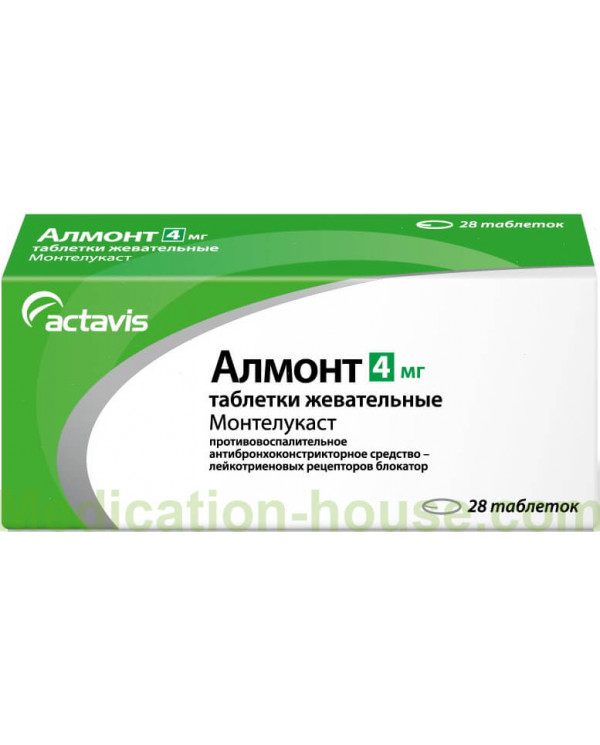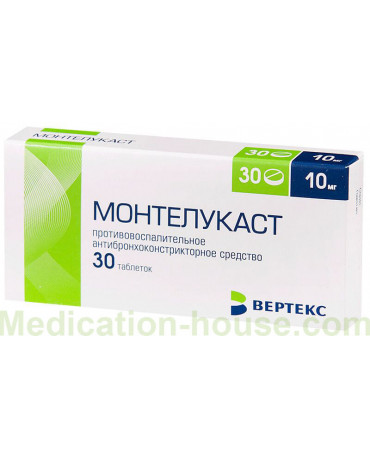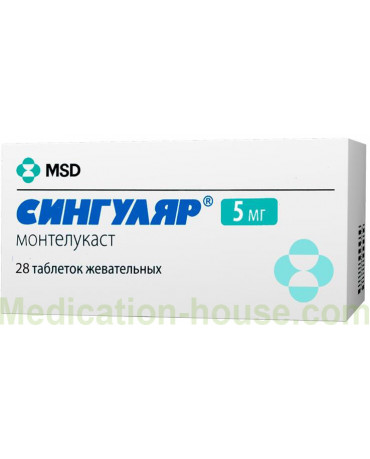Release form and composition
Dosage forms of Almont:
chewable tablets, dosage 4 mg: oval, biconvex, pink with a splash on one side - marking "M4" (10 pcs. in a blister, in a cardboard bundle 3 blisters; 14 pcs. in a blister, in a cardboard bundle 2 or 7 blisters)
Each pack also contains instructions for the use of Almont.
Composition 1 chewable tablet:
active substance: montelukast (in the form of the montelukast sodium salt) - 4 or 5 mg;
auxiliary components: croscarmellose sodium, hyprolose, microcrystalline cellulose, mannitol, aspartame, magnesium stearate, Pigment Blend PB-24880 (lactose monohydrate, iron oxide red), cherry flavor (Silarom Cherry Flavor 1219813182).
Pharmacodynamics
The active substance of Almont - montelukast - is an antagonist of leukotriene receptors. Cysteinyl-leukotrienes (LTC4, LTD4, LTE4) are strong pro-inflammatory eicosanoids released from various cells, including eosinophils and mast cells. These important pro-asthmatic mediators bind to cysteinyl-leukotriene (CysLT) receptors, which are located in the airways and are responsible for increased eosinophils, vascular permeability, sputum production and bronchospasm reaction.
Montelukast has a high affinity and selectivity for CysLT1 receptors. At a dose of up to 5 mg, the drug stops bronchospasm caused by inhalation of LTD4. After taking the pill inside, the bronchodilating effect develops within 2 hours.
Almont suppresses both the early and late stages of bronchospasm caused by exposure to antigens. Reduces the number of eosinophils in the peripheral blood, significantly reduces the number of eosinophils in the respiratory tract.
Montelukast enhances the bronchodilating effect of beta2-adrenergic agonists.
In patients with hypersensitivity to acetylsalicylic acid (ASA), receiving oral and / or inhaled glucocorticosteroids (GCS), the addition of montelukast to therapy can improve disease control.
Pharmacokinetics
The absorption of Montelukast after ingestion is quick and almost complete.
After fasting taking 5 mg chewable tablets in adults, the maximum plasma concentration (Cmax) is observed after 2 hours. The bioavailability is on average 73%, but decreases to 63% if Almont is taken with food.
In adults, after taking fasting coated tablets at a dose of 10 mg, the average Cmax value is reached within 3 hours. The bioavailability is on average 64%. With simultaneous ingestion of food, the values of Cmax and bioavailability do not change.
After fasting taking 4 mg chewable tablets in children 2–5 years old, Cmax is observed after 2 hours. In this age category, the average Cmax is 66% higher and the average minimum plasma concentration (Cmin) is lower than in adults after taking coated coated tablets at a dose of 10 mg.
Montelukast is characterized by a high bond with plasma proteins - more than 99%. At equilibrium, the distribution volume (Vd) is approximately 8–11 liters. In preclinical studies, it was found that the drug penetrates the blood-brain barrier in minimal quantities. In other tissues, 24 hours after administration, the drug is determined in low concentrations.
Montelukast undergoes an intensive metabolism in the liver. The equilibrium plasma concentration (Css) of metabolites during the use of Almont in therapeutic doses is not determined in either adults or children.
In vitro studies have found that isoenzymes of cytochrome P450 (2A6, 2C9 and 3A4) are involved in the metabolism of montelukast. The drug in therapeutic concentrations does not inhibit isoenzymes of cytochrome P450: 2A6, 2C9, 3A4, 2D6, 2C19, 1A2. Montelukast metabolites have negligible therapeutic activity.
In healthy adult volunteers, the plasma clearance of the drug averages 45 ml / min. About 86% of the total amount of montelukast is excreted within 5 days through the intestines. Not more than 0.2% is excreted by the kidneys. These data, along with bioavailability data confirm the excretion of montelukast and its metabolites mainly with bile.
In young healthy adult volunteers, the half-life (T1 / 2) is 2.7–5.5 hours.
Special clinical cases:
gender: in men and women, the pharmacokinetic characteristics of montelukast are the same;
advanced age: the pharmacokinetics of the drug does not change, therefore, dose adjustment is not required:
kidney function: in case of renal failure, the use of montelukast has not been studied, however, dose adjustment is not required, since the kidneys practically do not participate in the excretion of the drug;
liver function: with liver failure of mild to moderate severity, dose adjustment of Almont is not required. There is no information on the pharmacokinetics of montelukast in patients with severe functional impairment of the liver (more than 9 points on the Child-Pugh scale).
In the case of taking very high doses of montelukast (20 and 60 times the recommended dose for adults), a decrease in the plasma concentration of theophylline is noted. If you take Almont at the recommended therapeutic doses, this effect is absent.
Indications for use
Almont is intended for long-term treatment and prevention of asthma, including:
prevention of bronchospasm on the background of physical activity in children from 2 years old (chewable tablets 4 mg and 5 mg), in adolescents from 15 years old and adults (film-coated tablets 10 mg);
prevention of day and night symptoms of bronchial asthma in children from 2 years old (chewable tablets 4 mg and 5 mg), in adolescents from 15 years old and adults (film-coated tablets 10 mg);
treatment of asthma with hypersensitivity to acetylsalicylic acid in children over the age of 6 years (chewable tablets 4 mg and 5 mg), in adolescents from 15 years old and adults (film-coated tablets 10 mg).
Almont tablets are also used to alleviate the symptoms of perennial and seasonal allergic rhinitis in children from 2 years old (chewable tablets 4 mg and 5 mg), in adolescents from 15 years old and adults (film-coated tablets 10 mg).
Contraindications
glucose-galactose malabsorption, galactose intolerance, lactase deficiency;
phenylketonuria - for chewable tablets;
children's age up to 2 years - for 4 mg chewable tablets, up to 6 years - for 5 mg chewable tablets, up to 15 years - for 10 mg film-coated tablets;
hypersensitivity to any component of Almont tablets.
Almont, instructions for use: method and dosage
Almont should be taken orally:
film-coated tablets: swallow whole with plenty of water, regardless of meals;
chewable tablets: chew in the mouth until completely dissolved, 1 hour before a meal or 2 hours after a meal.
Adolescents from 15 years of age and adults are prescribed 1 tablet, film-coated (10 mg) 1 time per day.
For children under 14 years old, Almont is prescribed in the form of chewable tablets: for children 2–6 years old - at a dosage of 4 mg, for children 6–14 years old - at a dosage of 5 mg. Multiplicity of receptions - 1 time per day. In case of bronchial asthma or bronchial asthma with allergic rhinitis, the drug should be taken in the evening. In allergic rhinitis, the time of taking the drug does not matter, the treatment regimen is determined individually depending on the period of the greatest exacerbation of the symptoms of the disease.
Children should take pills under adult supervision.
In patients with bronchial asthma, the therapeutic effect of Almont, which allows controlling the symptoms, develops within a day after administration. The use of the drug is recommended to continue not only during an exacerbation of the disease, but also at the stage of a controlled course of asthma.
Side effects
respiratory system: nosebleeds;
hepatobiliary system: increased activity of hepatic transaminases, hepatitis (including hepatocellular, cholestatic and mixed liver lesions);
blood system: increased tendency to bleeding, thrombocytopenia;
cardiovascular system: palpitations;
nervous system and psyche: paresthesia / hypesthesia, drowsiness, dizziness, headache, cramps, tremors, irritability, agitation (including aggressive behavior or hostility), anxiety, anxiety, hallucinations, insomnia, pathological dreams (including nightmares) , somnambulism, disorientation, depression, suicidality (suicidal thoughts and behavior);
immune system: hypersensitivity, including eosinophilic liver infiltration, anaphylaxis;
digestive system: nausea, abdominal pain, dyspepsia, dry mouth, vomiting, diarrhea, pancreatitis;
musculoskeletal system: arthralgia, myalgia, including muscle cramps;
skin and subcutaneous fat: urticaria, erythema nodosum, rash, pruritus, prone to hematomas, angioedema, erythema multiforme;
infectious and parasitic diseases: upper respiratory tract infections;
other: thirst, swelling, malaise, fatigue, fever; in very rare cases - Cherge-Strauss syndrome.
Overdose
Montelukast has been reported in patients with chronic bronchial asthma for 1 week in a daily dose of 900 mg, and also for 22 weeks in a daily dose of more than 200 mg. Adverse events were not observed.
In clinical studies and the post-marketing period, cases of acute overdose of Almont (after taking at least 1000 mg per day) were recorded. According to clinical and laboratory data, in children, adults and the elderly, the safety profile of montelukast is similar. The following symptoms were most often noted: thirst, abdominal pain, vomiting, headache, psychomotor agitation, drowsiness.
In case of an overdose, symptomatic therapy is indicated. There is no information on the effectiveness of hemodialysis or peritoneal dialysis for removing the drug from the body.
special instructions
Almont is not intended for the relief of acute attacks of bronchial asthma. It is recommended that patients always have an emergency medicine with them - short-acting inhaled beta2-adrenergic agonists. In case of increased need for these funds, patients should consult their doctor as soon as possible.
You should not abruptly switch from Almont to oral / inhaled corticosteroids therapy. There is no information proving the possibility of reducing the dose of oral corticosteroids when Montelukast is added to therapy.
Against the background of anti-asthma therapy, in rare cases, systemic eosinophilia develops, sometimes accompanied by clinical symptoms of vasculitis - the so-called Cherge-Strauss syndrome. This condition is eliminated by taking systemic corticosteroids. Such cases are usually noted against the background of a dose reduction or withdrawal of oral GCS. The relationship of the antagonists of leukotriene receptors with the development of Church-Strauss syndrome is neither possible to confirm nor deny. Patients should be warned about the need to control the following symptoms: the occurrence of a vascular rash and eosinophilia, an increase in the severity of neuropathy, pulmonary symptoms, and / or heart complications. With their development, a repeated examination and revision of the treatment regimen are indicated.
Almont does not prevent the development of bronchospasm in patients with hypersensitivity to ASA when using ASA and other non-steroidal anti-inflammatory drugs (NSAIDs).
Influence on the ability to drive vehicles and complex mechanisms
In rare cases, dizziness and drowsiness are noted during montelukast therapy - undesirable effects that can adversely affect the speed of reactions and the ability to concentrate. Such patients are advised to refrain from performing potentially hazardous work and driving a car.
Pregnancy and lactation
Almont can be prescribed to pregnant women if the doctor determines that the benefits to the mother are higher than the potential risks to the fetus.
When treatment is required during lactation, it is recommended to assess the possible risks during therapy, if necessary, stop breastfeeding.
Use in childhood
Age-related contraindications to the appointment of the drug, depending on the dosage form of Almont:
chewable tablets 4 mg - up to 2 years;
5 mg chewable tablets - up to 6 years;
coated tablets 10 mg - up to 15 years.
With impaired renal function
The kidneys practically do not participate in the excretion of Almont, therefore, correction of the dosing regimen of montelukast for patients with renal failure is not required.
With impaired liver function
In mild to moderate hepatic insufficiency, dose adjustment of Almont is not required.
There is no experience with montelukast in patients with severe functional impairment of the liver (more than 9 points on the Child-Pugh scale).
Use in old age
The pharmacokinetics of the drug in elderly patients does not change, so there is no need to adjust the dose of Almont.
Drug interaction
Almont can be prescribed in conjunction with other drugs that are traditionally used for the prevention of bronchospasm and long-term treatment of bronchial asthma and / or allergic rhinitis.
Almont is considered a reasonable addition to monotherapy with bronchodilators, if their use does not adequately control bronchial asthma. After achieving a stable therapeutic effect with the addition of montelukast, the dose of bronchodilators can be gradually reduced.
Almont provides an additional effect to patients receiving inhaled corticosteroids. After achieving a stable therapeutic effect with the addition of montelukast under the supervision of a doctor, you can begin to gradually reduce the dose of corticosteroids. In some cases, inhaled GCS can be completely canceled. It is not recommended to abruptly replace inhalation therapy with Almont.
In the recommended therapeutic dose, montelukast does not have a clinically significant effect on the pharmacokinetics of the following drugs: digoxin, terfenadine, prednisone, prednisone, theophylline, warfarin, oral contraceptives (ethinyl estradiol / norethinodrel 35 ÷ 1).
With the simultaneous use of phenobarbital, the AUC of montelukast is slightly reduced (the area under the concentration-time curve), but this does not require a dose change.
Caution should be exercised, especially in the treatment of children, in the case of simultaneous use of inducers of the CYP3A4 isoenzyme, such as phenobarbital, phenytoin, rifampicin.
In vitro information was obtained that montelukast is a potent inhibitor of the CYP2C8 isoenzyme. However, in an in vivo study of the interaction of montelukast and rosiglitazone (a marker substrate that is primarily metabolized by the CYP2C8 isoenzyme), confirmation of these data was not obtained. Thus, the effect of montelukast on the CYP2C8-mediated metabolism of a number of drugs, including paclitaxel, repaglinide, and rosiglitazone, is not expected in clinical practice.
In vitro, it was found that montelukast is a substrate of the CYP2C8 isoenzyme, and to a lesser extent, the CYP3A4 and CYP2C9 isoenzymes. In clinical studies of the interaction of montelukast and gemfibrozil (an inhibitor of both CYP2C9 and CYP2C8), the latter increased the effect of systemic exposure to montelukast 4.4 times. When itraconazole was added to gemfibrozil and montelukast (it is a strong inhibitor of the CYP3A4 isoenzyme), there was no additional increase in the effect of systemic exposure to montelukast. Given the safety data when using the drug in doses exceeding the recommended dose for adults of 10 mg, the effect of gemfibrozil on the systemic effects of montelukast cannot be considered clinically significant. Thus, with the combined use of these drugs, there is no need to adjust the dose.
Based on the results of in vitro studies, clinically significant drug interactions with other known inhibitors of the CYP2C8 isoenzyme (e.g., trimethoprim) are not expected. Moreover, the simultaneous use of itraconazole alone with montelukast did not cause a significant increase in the effect of systemic exposure to montelukast.
Terms and conditions of storage
Store in the original packaging out of the reach of children at a temperature: chewable tablets - up to 30 ° C, film-coated tablets - up to 25 ° C.
Shelf life is 3 years.
Reviews
According to reviews, Almont is an effective drug that prevents the development of bronchospasm, and also eliminates the symptoms of allergic rhinitis. The treatment is well tolerated, there are no reports of the development of adverse reactions.
The drug is considered by many to be expensive. However, many patients indicate that the price of Almont is lower than the cost of many drugs with a similar active substance.
Terms of sell
You can buy Almont without a prescription.



